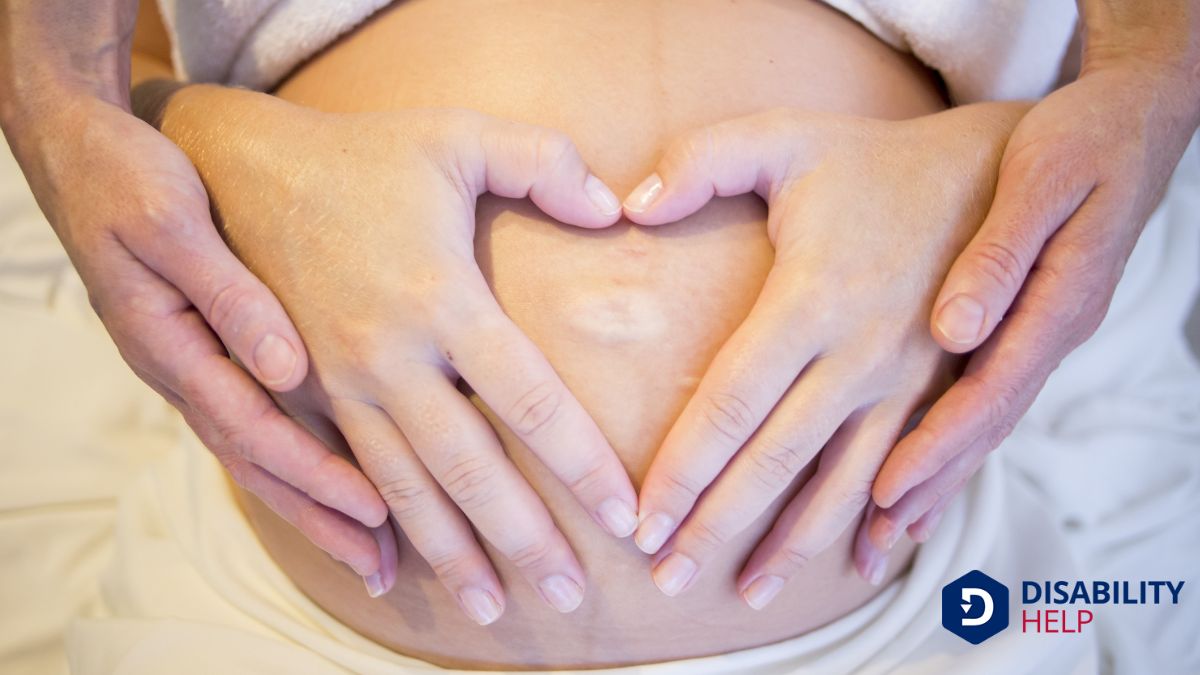Yes, pregnancy qualifies for short-term disability benefitsFinancial assistance provided to individuals who are unable to work due to a disability, such as Soc... since it's a temporary medical condition. Typically, these benefits cover a portion of our salary during maternity leave, helping ease financial stress. Expect coverage for up to six weeks for vaginal deliveries and eight weeks for cesarean sections. A doctor's certification is essential if complications arise. Employer-sponsored or private plans offer different terms, so understanding our options can maximize benefits. Discovering more details will enhance financial planning.
Key Takeaways
- Pregnancy is classified as a medical condition under short-term disability insuranceInsurance that provides income replacement for a limited time when an employee is unable to work due....
- Short-term disability typically covers six weeks for vaginal deliveries and eight weeks for cesarean sections.
- A doctor's certification is required to confirm that pregnancy affects job performance.
- Severe pregnancy complications may qualify for extended short-term disability benefits.
- Understanding policy specifics is crucial for maximizing short-term disability benefits during pregnancy.
Understanding Short-Term Disability Insurance

Short-term disability insuranceA form of insurance that provides income to individuals who are unable to work due to a disability., often an essential safety net, is designed to provide financial support when we're unable to work due to a temporary medical condition, including pregnancy. This insurance helps us cover expenses during a period when our regular income might be paused.
It’s vital to understand how it works, as not all of us may be familiar with its benefits. Policies vary, but generally, short-term disability covers a percentage of our salary for a specified period.
We need to know the waiting period before benefits kick in and how long they last. Understanding these details helps us plan better for unexpected situations.
Let’s make sure we're aware of our policy terms to maximize our benefits and maintain financial stability during challenging times.
How Pregnancy Is Classified Under Short-Term Disability
When we consider pregnancy under short-term disability, it's important to recognize it as a medical condition that qualifies for coverage.
We'll explore how the coverage duration and terms vary, often depending on the policy specifics and our personal circumstances.
Understanding the role of a doctor's certification is essential, as it typically serves as a requirement to secure these benefits.
Pregnancy as a Medical Condition
Pregnancy is more than a natural life event; it’s often classified as a medical condition under short-term disability benefits. This classification acknowledges the physical changes and challenges pregnancy brings.
It's recognized that pregnancy can impact our ability to work, and it’s essential to recognize these effects. Short-term disability benefits aim to support us during this significant time, offering financial assistance when we might need to take time off due to pregnancy-related health issues.
By classifying pregnancy as a medical condition, these benefits provide an acknowledgment of the potential complexities involved, from morning sickness to more severe complications.
It’s important for us to know how these benefits work so we can plan and make informed decisions about our health and well-being.
Coverage Duration and Terms
Recognizing pregnancy as a medical condition under short-term disability benefits leads us to explore the specifics of coverage duration and terms.
Typically, short-term disability policies offer coverage for a set period, often ranging from six to eight weeks after delivery, depending on the type of birth. Vaginal deliveries usually receive six weeks, while cesarean sections might be covered for eight weeks. However, this can vary based on the insurer and your specific policy.
We should also be aware that coverage terms might include a waiting period before benefits kick in, and the percentage of income replaced also varies.
It's vital to review our policy details, as these terms can greatly impact our financial planning during maternity leave. Understanding these nuances guarantees we're well-prepared for this important life event.
Doctor's Certification Requirements
Guaranteeing we qualify for short-term disability benefits during pregnancy often hinges on obtaining a doctor's certification. This document confirms that our pregnancy affects our ability to perform job duties, which is necessary for benefits eligibility.
Our healthcare provider needs to specify how pregnancy complications or recovery periods impair our daily work functions. It's not just about being pregnant; it’s about the medical necessity for leave.
To promote clarity, we should discuss our situation thoroughly with our doctor, clearly explaining our work demands. This helps them provide a detailed and accurate certification.
Conditions and Complications That Qualify
As we explore how pregnancy-related conditions qualify for short-term disability benefits, let's consider the various factors at play.
Some pregnancies are classified as high-risk due to specific medical criteria, which can impact eligibility.
Additionally, complications during postpartum recovery can also qualify for these benefits, ensuring necessary support during this critical time.
Pregnancy-Related Medical Conditions
When steering through the complexities of pregnancy, it's crucial to understand which medical conditions and complications qualify for short-term disability benefits.
Conditions like severe morning sickness, also known as hyperemesis gravidarum, can make it almost impossible for us to continue working.
Gestational diabetesA chronic condition where the body cannot produce or properly use insulin, leading to high blood sug... is another condition that might qualify, as it requires careful management and routine monitoring to guarantee both the mother's and baby's health.
Preeclampsia, characterized by high blood pressure, can pose serious risks and often necessitates rest and medical attention.
Placenta previa, where the placenta covers the cervix, can also lead to significant complications, requiring us to avoid certain activities.
Recognizing these conditions helps us navigate the process of obtaining the benefits we need during challenging times.
High-Risk Pregnancy Criteria
Maneuvering a high-risk pregnancy involves understanding the specific criteria that determine whether a pregnancy falls into this category.
Recognizing these factors helps us manage expectations and plan for necessary support. Here are some key conditions that might classify a pregnancy as high-risk:
- Chronic Health Conditions: If we've pre-existing conditions like hypertension or diabetes, our pregnancy might require more attention.
- Pregnancy-Related Issues: Complications such as preeclampsia or gestational diabetes can arise, making it essential for us to be vigilant.
- Multiple Pregnancies: Carrying twins, triplets, or more increases the risk, demanding closer monitoring.
Understanding these criteria isn't just about qualifying for benefits; it's about ensuring both our health and the baby's are prioritized.
Let's navigate this together.
Postpartum Recovery Complications
Steering a high-risk pregnancy sets the stage for understanding the potential challenges that might arise during postpartum recovery.
We understand that while childbirth is a considerable life event, it doesn’t always wrap up neatly once the baby arrives. Complications like infections, excessive bleeding, or postpartum depressionA mental health condition marked by persistent feelings of sadness and loss of interest. can greatly impact recovery.
These conditions may qualify us for short-term disability benefits, offering much-needed support during a vulnerable time. It’s crucial to recognize these issues early and seek appropriate medical help to guarantee a smoother path to recovery.
By understanding our rights and the benefits available, we can better advocate for ourselves and secure the assistance we need.
Let’s prioritize our health and well-being as we navigate postpartum life.
Steps to Apply for Short-Term Disability Benefits
To apply for short-term disability benefits, it's crucial to start by gathering all necessary documentation and information.
Let's navigate this process together, ensuring a smooth journey ahead. First, we should confirm eligibility by reviewing our plan's specific terms.
Next, we need to collect medical documentation from our healthcare provider, detailing our pregnancy and any complications.
Finally, let's fill out the application forms accurately and thoroughly, emphasizing all relevant information.
Here's a quick guide to help us on this path:
- Eligibility Check: Verify our plan's coverage and waiting period.
- Medical Documentation: Obtain a doctor's certification outlining our condition.
- Accurate Application: Submit completed forms promptly to avoid delays.
Employer-Sponsored vs. Private Short-Term Disability Plans
While weighing our options for short-term disability plans, understanding the differences between employer-sponsored and private plans is essential.
Employer-sponsored plans are often more affordable since companies usually cover a portion of the premium. These plans might offer automatic enrollment, making them convenient. However, they could have limited coverage options, and if we change jobs, we might lose the benefits.
On the other hand, private short-term disability plans offer more flexibility. We can customize coverage based on our specific needs and maintain the plan regardless of job changes.
However, private plans can be more expensive, as we bear the full cost of premiums. Evaluating our financial situation and coverage requirements will help us decide which type best suits our pregnancy-related needs.
Tips for Maximizing Your Benefits During Pregnancy

When planning for pregnancy, it’s essential to make the most of our short-term disability benefits. Knowing how to navigate this can ease our financial concerns and give us peace of mind.
Here’s how we can maximize our benefits:
- Review Our Policy: Let’s dig into the details of our current plan. Understanding what’s covered, such as maternity leave, helps us anticipate our income during this critical time.
- Communicate with HR: Open a dialogue with our HR department early. They can provide insights on the process and any paperwork we need to complete.
- Plan Financially: Start budgeting to cover any gaps. Having a financial cushion guarantees we’re prepared for any unexpected costs.
Conclusion
To summarize, we've explored how short-term disability insurance can be a valuable resource during pregnancy. By understanding how pregnancy is classified, recognizing the conditions and complications that qualify, and knowing the steps to apply, we can better navigate this process. Whether through employer-sponsored or private plans, being informed helps us maximize our benefits. Let's take proactive steps to guarantee we receive the support we need, allowing us to focus on our health and growing families.






